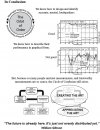No my question isn't answered at all by appeal to music sales. I'm talking about sound quality, not music quality. People can appreciate music on all sorts of devices, from old transistor radios, crappy turntables, laptops or name the "worst measuring" speaker brand you want. Whatever people like musically doesn't help tell us anything about sound quality.
One way to think about my question is to ask yourself: If you wanted to demonstrate your hi-fi system to a non-audiophile, that is show what it can do as opposed to much poorer quality systems most people might be used to, what demo tracks would you select and why?
Personally, I've used various demo tracks over the years. I can put on some recordings - e.g. vividly recorded vocals with light acoustic accompaniment (e.g. some Astrud Gilberto tracks, virtually everyone likes the music) and every time...every single time...the listener is blown away. All rate the sound quality they are hearing as very high. Why? Always the same reaction
"It Sounds So Real!!!" Most people never even have an inkling of what a high end system can do in sonic terms, or even think music can "sound realistic" so they tend to be shocked to encounter such sound. (Of course I'm not talking perfectly indistinguishable from live - as Dr. Toole says, stereo is compromised. But certainly "much CLOSER to the real thing" than most people have heard).
So, if you were to show a non-audiophile what your system is capable of...why you have put so much time, attention (and possibly money relative to a non-audiophile) in to it...what type of recordings would you use? Presumably you wouldn't use a horrendous, thin, scratchy recording right? So just think about the general attributes that you think will tend to bring forth a response "that sounds really good." What would those be?
ETA: Apparently Harman has a list of recommended tracks:
Harman Art of Listening Playlist · Playlist · 24 songs · 141 likes

open.spotify.com
So it would be relevant to ask: is there a general trend in there in terms of why they were chosen, such that they would reveal what people will judge as "good sound?" (I've given my own answers on this before, but I'm interested in Dr. Toole's view, and certainly in yours too Newman).
It's a bit of a philosophical chicken-or-the-egg question. What Makes For Good Sound Quality? You can't say "speakers that measure well" because they won't sound "good" to people if the recordings themselves sound "bad." But then, it can't just be the recording itself: if you play a "good recording" through a "bad speaker" then you'll get "bad sound." So then what is the measure of a "good recording?" For sound reproduction quality, neither appeal to the recording itself, nor the speaker itself, can tell us what Good Sound is. Which implies we have some sort of notion of "good sound when we hear it" criteria. (And at least one viable criteria - maybe not the only - would be "sounds like the real thing." I'm sure there are other touchstones too).



